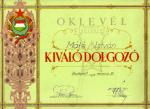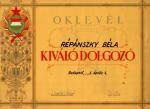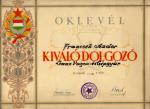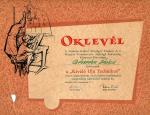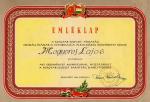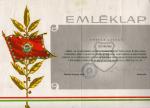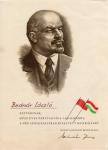-
Posts
2,660 -
Joined
-
Last visited
Content Type
Profiles
Forums
Blogs
Gallery
Events
Store
Everything posted by hunyadi
-

Hungary Hungarian Miners Uniform
hunyadi replied to Gordon Craig's topic in Central & Eastern European States
Not 100% certian, but I think it was called the KISz Medal of Merit (????) -

Hungary Hungarian Miners Uniform
hunyadi replied to Gordon Craig's topic in Central & Eastern European States
And KISz and the Munkasor! -

Hungary Hungarian Partisan Badge Database
hunyadi replied to hunyadi's topic in Central & Eastern European States
Yes - there are, but from what I have seen, they are regualted to certain 'fields' like economics, film, etc... this book is the 'whos who' of the partizan. The book was compiled from the research of about 50 writers and was published by the Hungarian Military Museum. That may be a place to go back and look? -

Hungary Hungarian Partisan Badge Database
hunyadi replied to hunyadi's topic in Central & Eastern European States
Just recently I was able to aquire a rare copy of the Partizan 'Little' Lexicon. In this book are the biographies of aproximately 1500 men and women who were considered the 'true' partizans, rather than the more 'political' assumption to the Hungarian Partizans Association. From looking at the number database and the the database we aquired at the National Museum, almost every badge under the 1500 number was given to individuals who actualy participated in anti-fascist acitivity. Unfortunatly, the book does not give the numbers of the badge and the name to go with them, but as Mr. Sandor Pal was #444 his bio was in the book: Sandor Pal was a philosopher and a political leader in the partizan movement. He practiced as a university teacher before WW2 and in 1919 joined the Communist Hungarian Party (Kun Bela). He escaped "abroad" (probably Russia) and returned in 1927 to work as a publisher and editor of the periodical "Society Outlook". During the war he joined with the 'Hamza' partizan group, which was comprised mostly of film and media artists (!!) He worked with the civilian sector of enlisintg partizans alongside Somogyi Miklos who recruited actual soldeirs. Pal worked througout the nation in work sabotage, communications, and producing forged documents. In all Pal worked in context with 13 different partizan groups. Pal's greatest acomplishment was managing to steal an address list of Hungarian and German State Security agents GESTAPO and Aroow Cross) operating in Hungary which was then distributed to the various partizan groups. For all his work as a good communist he was arrested, tortured and interogated as a 'Titoist' spy and spent the years 1950-1954 in prison. After his release from prison he became the director od the National Translation Office. In 1956 he was accepted back into the party and from 1957 he worked as the head of the philosopy department at two national univerisites SOTG and ELTE. sadly, none of the names in the two otehr award books Gordon and I have appear in the lexicon. If anoyone has a document, post the name and if the name is in the book, I can translate it. Additionaly - I have been trying unsucessfuly at getting more interviews with the current Partizan Association...but perhaps a door will open soon! -

Hungary Order of Labor in Gold
hunyadi replied to hunyadi's topic in Central & Eastern European States
The only type that I have seen appart is a three rivet type. If you closely look at Hungarian awards, they made some great designs, but many had flaws that were from time to time reivsed. Case study of the crossed PPSH's on the Order of Merit of Distingushed Service. First types had glued on PPSH's - then they must have fell off, because the next form rivited them on. As the first oval type of multiple construction appears to be eitehr pressed together or more than likely glued, I would say that there was probably some problems with them coming appart as in 1954 they began the 32 ray with the three rivets to hold it all together. There are no three piece single rivet 32 ray types out there in any publication or that I have observed. -

Hungary Order of Labor in Gold
hunyadi replied to hunyadi's topic in Central & Eastern European States
reverse of the 32 ray Order of Labor in Gold. This is a three piece construction (wheat shaft 'frame', the enameled center section and the enameled star.) -

Hungary Order of Labor in Gold
hunyadi replied to hunyadi's topic in Central & Eastern European States
Order of Labor in Gold '32 ray' type issued from 1954 to the 1970's perhaps even to 1985. This one has a ribbon variant where the ribbon was used from ribbon stock for other medals. These were then simply dyed red, though obviously it was not able to hold out the other colors of silk. -

Hungary Order of Labor in Gold
hunyadi replied to hunyadi's topic in Central & Eastern European States
-
Folks here my comprehensive understanding of the time line for all of the grades and production types of the Order of Labor The Order of Labor and a similar Merit Medal of Labor were instituted on February 25th, 1948 by the Hungarian parliament. The Order and the Medal were intended ?to reward those who had performed exceptionally in building up the Hungarian cultural and social programs as established by the working goals of the Three Year Plan?. (the three year plan had been established in 1947 to bring Hungary out of the post war recession) The Order of Labor was bestowed in three classes of gold, silver and bronze. It was also the first time a cash award was bestowed to the recipient. Gold class recieved the amazingly large sum of 5000 forints. The silver grade was awarded with 3000 forints and the bronze a still substantial 1500 forints. Additionally the plan was formulated by parliament to limit the besotwal. Only 50 gold 100 silver and 200 bronze awards were to be given annually. The 1948 Order of Labor was a round medal 43mm in diameter with two shafts of wheat growing from the bottom and running along the perimeter of the medal. In the center was a cog wheel with an enameled shield in the center. The cog wheel was then superimposed over an enameled red star (industry runs communism) The Merit Medal was similar but it only came in one class, the star was not enameled and the medal itself was only 40mm in diameter. On August 20th, 1949 Rakosi and the Hungarian Workers Party enacted a constitution so similar to the constitution of the Soviet Union, it was nearly absurd. Regardless, the effect of the one party rule came about and the Workers Party determined the symbolsim. On September 13th, 1950 the Order of Labor and the Merit Medal were redesigned. This is the more commonly understood form of an oval shaped medal with a central star framed by two shafts of wheat. Like its predecessor, the Order of Labor remained in three grades of gold, silver and bronze. The Merit Medal was the same dimension as the Order of Labor, but was devoid of the enameled field behund the red enameled star. The 1950 Order of Labor and Merit Medal were 43mm tall x 33mm wide. In the center was a red enameled star superimposed over a white enameled field with 16 'rays'. The medal perimeter was framed by two growing shafts of wheat. At the base was the simplified form of an arched bridge with a crossed hammer and torch at the apex of the bridge. The reverse of the medal is either stamped or constructed from three solid pieces. The stamped variety (earlier forms) have the date "1949" on the reverse. Others, more commonly seen in the multi piece construction types are devoid of the inception date. Additionally the 'rays' behind the star was the sculptor's attempt at making an abstraction of the former cog wheel, but this time the 'star (communism) runs labor'. In early 1953 the Hungarian Parliament (now in a simple role to keep tradition alive. The party asks, the ministers respond by saying 'yes') passed the 5th law which abolished all previous forms of the Order of Labor and the Merit Medal of Labor. Replacing these was the 'Order of Labor' which was the exact same strike as the Order of Labor in Gold 1950 type. The other grades of silver or bronze dissapear. A year later in 1954 a new form is made of the Order of Labor; the 32 'ray' type. Still, the Order of Labor is awarded in the single grade. Then in 1963 the 35th law created the Order of Labor in three grades once again. The rebirth of the three grades adopetd the 32 'ray' design. Typiclay these are observed in the three piece construction with rivets and hot enamel. There is also a variant that seems to ahve appeared in the 1970s that is a one piece base with an enameled star riveted on. In 1985 the Order of Labor underwent another change. This type is constructed of a singe piece and is struck as a convex form. The star is attached by a rivet. So - to recap 1948 Order of Labor in Gold, Silver and Bronze. Also the Merit Medal of Labor (round medal style with cog wheel) 1950 Order of Labor in Gold, Silver and Bronze. Merit medal of Labor is retained. (new oval shaped 16 ray design) 1953 Order of Labor. All previous forms of gold, silver and bronze grades disapears along with the Merit Medal of Labor. The Order of Labor for this type only comes in gold. 1954 Order of Labor introduced with 32 rays. Still only bestowed in gold. 1963 Order of Labor reintorduced in three grades of Gold, Silver and Bronze 1985 Order of Labor is desigedn with a convex form
-

Hungary A MUNKA ?RDEMREND BRONZ FOKOZATA
hunyadi replied to Gordon Craig's topic in Central & Eastern European States
I think the best thing to do would be to clean up the threads at this point and go from there. We are all very good at finding variations and should share them. It should not be too difficult as from what I can see there are about 10 variations and types in total. Lets start a Gold thread as a model to fix the silver and bronze...???? -

Hungary A MUNKA ?RDEMREND BRONZ FOKOZATA
hunyadi replied to Gordon Craig's topic in Central & Eastern European States
My head is hurting with all these 'types'. Rick I like your terminology, but I also like the Type 1.0, Type 1.1 'strawberry' etc...Anyhow can we make a list? my suggestion 1.0 (16 ray variety) 1.1 stamped reverse with date 1.2 stamped reverse w/o date 1.3 two piece solid single rivet for star etc... 2.0 (32 ray) 2.1 three piece riveted 2.2 one piece 2.3 one piece dished we can add the sub variants of 1948, 1953, 1954, 1964, 1985 etc... just my suggestion... -

Hungary Order of Labour-Silver Class
hunyadi replied to a topic in Central & Eastern European States
Very nice mid 60's three piece silver Order of Labor. Saw one the other day with a 'frosted' back. As for awarding them. They were not awarded in order. The 'king tut's tomb' lot that I have, the woman recived the bronze grade in the 1970's after 20 years of working for the propoganda department. Then in the 1980's she was awarded the gold grade. This was pretty common as many workers who 'built up' the HUPR after 1956 were retiring in 1986. The state made huge sums of bestowals of the gold grade (as well as the silver and bronze) Regardelss - the determination of who got one and what grade was determined abstractly by "management" (council of ministers) -

Hungary 1941 Hungarian tunic tailor's tag help
hunyadi replied to rathbonemuseum's topic in Central & Eastern European States
This is a nice tunic and cap, but for sure its been dinkered with. I would look at the Ostfront Ribbon very carefuly, I see alot of tunics that are sold with 'non glow' ribbon, but its completely superfulious. The ribbon bar is an interesting addition, but without the fire cross, it does not make much sense, esp. due to the Ostfront ribbon. The loops on the tunic may be for a 'modified' metal wing, but no way to be certain. As the tunic was issued in 1941, its highly unlikely that it was a para tunic. The para units were factored as being infantry that fell out of the sky so they wore the reagular infantry uniform. There could be the outside chance that it was an para NCO that switched to the AF before his wings expired. Regulations called for qualifying every year to keep your wings, the master badge being the only exception. Off the top of my head it was 3 jumps per year to keep the basic wings, hence this gives you the factor of why these para wings are so, so rare. If this were the case with this tunic, its probably one-of-a-kind, but with other things being dinkered with...hmmmm... The beret is correct in 'look' the beret used a black silk band around the base, but the stickting on that looks like it fell off and somoeone added it later. The eage is also a modern eagle, struck off of nearly identical dies as the wartime one, except the space between the crown and the turul bird should be cut out. The black velevet material appears to be correct, but it looks a bit modern to me as well....all in all - its still an uncommon tunic and with a little more work will be a nice representation of a period NCO. -
Whats interesting and ommitted in the list of awards is his WW1 Victory Medal for being at West Point when the war for the USA began.
-
Though Gordon posted one of these before, this is the award certificate for the Socialist Brigade award.
-
And one from the 1970's. If you hadn't seen it beofre, for each decade, they used a differnt color paper. For the 1950's it was an off white, the 1960's a yellow and though this one does not look like it, the 1970's was an aquamarine blue
-
-
One thing that I like to collect are the Kivalo Dolgozo badges and documents. Especially nice are the formal documents. Afer going through and picking some out to scan, I learned something new. Here is one from the 1950's
-
Another document to the same man for being awarded the title of 'Excelent Youth Technician' (I would assume that there was no medal given for this, only the honor of the title)
-
-
This document is one for the Soviet Hungarian Association from 1955 to commemorate 10 years of liberation.
-
This is a document for the same man, declaring that he has sucesfully served his requirement to the Hungarian People's Ared Forces(he turned 50 years old, and therefore was not required to be called up in the event of war...)
-
On the eve of a new year, its snowing and I had a pile of documents that I was meaning to scan... These are just a sample of some of the documents that were awarded and were intended for framing and hanging on the wall, in many instances the quality and detail of the prints are quite spectacular. First one is a document for 20 years of Party membership, the engraving of Lenin is quite nice. The signature at the bottom is an auto-pen of Janos Kadar, the leader of the HUPR from 1957 to 1989.
-

Hungary 1941 Hungarian tunic tailor's tag help
hunyadi replied to rathbonemuseum's topic in Central & Eastern European States
Top reads 'National Clothing Institute" (Orszagos Ruhazatt Intezet) then Budapest 5th District Fotvos Square (Budapest V. Fotvos Ter) Name: Keresztes Akos Number: (szam) 283 194(1) - IIIrd month (possibly IIII???) 30th day How about a look at the full uniform??







